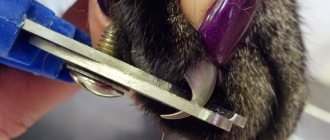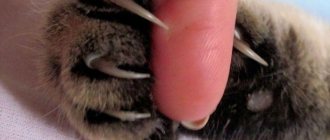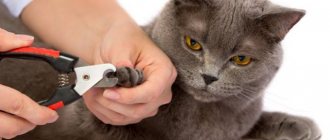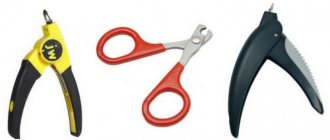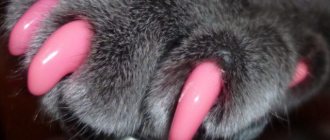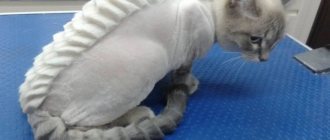By purchasing a fluffy kitten, each owner takes responsibility for caring for a new friend.
In addition to feeding, bathing and combing the fur, the pet needs to periodically trim its overgrown claws. We will tell you how to trim a cat’s claws at home correctly and painlessly in our educational article! Many owners of furry pets wonder why they should trim their cat’s claws at all and how important is this procedure? Any female cat's claws grow throughout her life.
Yard animals independently adjust their length by scratching against the asphalt and tree bark. But it is not easy for domestic cats to do this, so to create the optimal length of their claws, a caring owner and a special tool - a nail clipper - are involved. There are also silicone claw covers for all cat breeds.
If the claws are not trimmed, the consequences can be quite unpleasant, both for the animal itself and for its owner. Too large claws disturb the animal, and there is also a risk of them growing into the pad of the paws, which will cause pain. It will be difficult and quite painful for the cat to move on its paws.
In addition to tormenting the animal, overgrown claws can significantly spoil the appearance of the furniture in the house. The British or British Fold is patient with this procedure, as he has a calm nature by nature, but can fight back. A fluffy kitten, obeying its natural instinct, will definitely find a suitable surface for combing them.
This could be the owner’s favorite sofa, walls with new wallpaper, the door of a stylish cabinet, etc. Do you want to avoid such unpleasant consequences? Then don’t be lazy and regularly trim your beloved pet’s overgrown nails! There is also a special anti-scratch that helps prevent damage to your furniture or you from the animal.
Why do you need to trim your nails?
Claws are horny skin formations that grow throughout life. Under natural conditions, claws are regularly worn down during life. An animal does not need to worry about shortening its nails, as a person does: nature itself does manicures for cats. Those animals that their owners release to frolic in the wild wear off their claws by climbing trees and running on asphalt.
Domestic cats also try to trim their claws on the owner's walls, scratch the door frame and any wooden covering. How many times can you hear the indignation of owners about torn walls, upholstered furniture and numerous traces of cat scratches!
A scratching post allows cats to act in accordance with their instincts, but this does not help much - it’s trite, the cat can ignore the convenient device and enthusiastically continue to tear apart the corner of his favorite sofa. However, the scratching post will not have a significant effect on shortening the cat’s claws.
If you do not help the animal and do not trim the cat's claws, then long claws may grow into the pads of the paws, and the animal will suffer while walking.
All claws in one session, or one paw every day?
Everyone chooses a nail trimming scheme according to their own employment and the level of patience of the animal. How to trim a cat's claws in one fell swoop if she gets nervous and struggles? A short-term procedure in this case is impossible a priori, since everything may end with more or less neatly trimmed claws, but an unpleasant side effect can manifest itself in the form of irritation of the owner and severe fright of the animal.
After treating the claws, you need to praise the cat for its endurance
More humane, although it takes much longer, would be to repeat the procedure every day - it takes much less of the owner’s nerves per paw, and the cat will get used to the procedure in 4 days and will behave much calmer.
After treating the claws, you need to spend some time with your pet, praise him for his endurance (animals understand this very well), play with him, and treat him with a treat. This way, the animal will not develop a final and irrevocable aversion to trimming its claws - it will be interested in the process being completed as quickly and efficiently as possible, because it is followed by a reward.
If you notice blood on a claw, you should not panic
When to trim your nails
For a cat, the procedure is rarely pleasant. For the first time, few pets will allow the owner to not only touch their claws, but also trim them. Therefore, it is recommended to start at an early age. This way the pet can gradually get used to it.
First, you need to pick him up, stroke his paws, lightly pressing on the pads.
So that he does not resist during further actions. You should not cut kittens' claws while playing, when they are excited or hungry. It is best to do this during sleep, or when the kitten is calm.
If during trimming he breaks out, gets agitated, scratches or tries to bite, it is better to postpone the procedure.
How to prepare a cat
You need to catch the best moment for a haircut. It is better for the cat to be sleepy, or at least calm. But you shouldn’t grab it during the game or start the procedure by force. The reaction will be rejection and it will be quite difficult to catch the animal again. The most convenient tools are those with rubber linings; the handles have metal surfaces; your hand can slip. You can reduce the likelihood of traumatic situations by swaddling your pet. This is a fairly effective way to regulate the length of your cat's claws.
You should not expect that your cat will react normally to such a procedure from the very beginning. The claws will have to be exposed by pressing the pad as a result of stroking the paw. This method is especially effective for kittens. They get used to it and no further difficulties arise. At the start, the animal needs to be petted; it is useful to talk to it, calming it down. The cat will need time to get used to this procedure. At this time, the owner should be patient.
During the operation, do not forget to praise your pet, even if he is worried. To alleviate stress, he should be given a vitamin or, better yet, a treat. This will get him a little used to the idea that a haircut isn't so bad.
Nail trimming procedure
The procedure itself does not look scary if you prepare for it correctly and follow the recommendations.
Basic Rules
Before starting the procedure, you must wash your hands and thoroughly sterilize the instrument. The next steps are as follows:
- Hold the paw so that it does not slip out, do not press too hard, the touch should be gentle.
- Press down the pillow a little so that the claw appears.
- If you look closely, you can see that the claw has pinkish tissue inside. This is a pulp, it contains nerves and blood vessels, it cannot be touched. The edge is cut so that there is at least 2 mm to the pulp. If the claws are dark, you will have to act blindly, in several approaches, cutting off 1 mm each time.
- The trimmer should be held perpendicular to the top, trying to cut what you need at a time. This is a matter of habit; after a while everything will happen easier and faster. At the end of the procedure, the edges should be adjusted to make it more comfortable for the pet to walk and avoid injury.
- For the first time, you can use the help of another person to hold the cat. Sometimes in furry breeds, heavily grown hairs can cover the claw. This is where a clipper will come to the rescue if the cat is not afraid of it.
All claws should be trimmed; there are 5 of them on the front paws and 4 on the hind paws. Many often forget about such asymmetry, and without making sure, they leave the old claw, which over time begins to cause pain.
How often to perform the procedure
The best interval is 2 weeks between nail trimmings. This figure varies for each pet, which is influenced by the following factors:
- Nail growth rate . It varies from person to person and depends on nutrition and the presence of sufficient calcium.
- Color . Dark claws grow more slowly.
- Lifestyle . Cats are different, some can be lazy or very active. The latter often play and quickly wear down their claws. Lazy pets require more frequent grooming.
- Participation in inspections and exhibitions . Pedicure before the show is mandatory. But to avoid injury, you have to calculate the length of your swing. The usual 2-3 millimeters may be too much, especially after several days have passed from the previous haircut. You must act carefully.
When is it better to reschedule the procedure?
There are situations when it is better to delay the procedure. If the animal breaks free, you should not take the scissors, this will increase the risk of injury, and you can even twist the paw.
In weakened and sick cats and pregnant cats, stress can aggravate the situation.
It happens that the pet's mood changes and he does not break free. In this case, you will have to put up with cutting off 1-2 claws at a time.
How to trim the nails of an aggressive cat
Not all cats like such manipulations, so owners are often concerned about how to trim the claws of an aggressive animal. To do this, you must follow these rules:
- Find the moment when the cat is in the calmest state.
- To ensure your pet's safety, it should be swaddled. This solution is the most convenient for animals with a difficult character.
- The subsequent steps of the procedure do not differ from the usual one. During the entire process, you should pet and praise your pet.
Cat Nail Trimming Tools
Before telling you what tools are used to trim a cat’s claws, it is worth warning that they are not used under any circumstances: ordinary scissors are not suitable, however, neither is the housewife’s favorite manicure set. As an exception, sometimes only a nail file is used for polishing nails.
Specialized pet stores are not uncommon, as are veterinary pharmacies, so you can safely purchase a variety of cat care supplies there. In such places they will always advise and select convenient tools and even give advice on how to trim a cat’s claws .
What is used for cat manicure:
- a nail clipper, which must be sharp. Dull blades often hit sensitive areas and cause pain. Nail clippers are divided into sickle and guillotine clippers;
- a blood stopper or antiseptic. These medications may come in handy if you hit a sensitive part. Iodine or hydrogen peroxide work great. After cauterization, the wound is sprinkled with baby talcum powder;
- blisters - special scissors that look like manicure scissors, but are designed to resemble a cat’s claw;
- file for polishing;
- Long-haired cat breeds, such as Persians, will need a hair clipper, as fur on the paws interferes with the claw trimming process. If the cat is shy or the sound of the running machine irritates him, then the fur from the paws is cut off by hand using scissors;
- alcohol to disinfect accessories. All nail trimming tools must be sanitized before the procedure begins.
How to choose the right tool
There are times when owners, due to inexperience or ignorance, try to trim their dog’s nails with ordinary household scissors. Should not be doing that! Such “cutters” are simply not designed for such cases. Moreover, such pruning can lead to splitting of your pet’s claw.
For dogs in the trade there is a huge selection of nail clippers of 2 rod types:
- guillotine;
- with a sickle-shaped blade.
A tool with a sickle-shaped blade is used for strong nails of large breeds of dogs.
They have two meandering blades and a limiter. A nail cutter with a limiter adjusts the opening of the blades to the size of the claw, which is very convenient. A guillotine-type nail clipper is intended for small and medium-sized dogs. Their structure provides a ring into which you must first insert the claw, and then carefully trim it. The most convenient way to select a nail clipper is directly at the pet store. Since, in addition to the variety, nail clippers also come in different sizes, you should choose this durable and convenient tool with your dog.
For proper selection, you can trim the tip of your pet’s claw and observe whether it has split. The cut must be smooth and even. This goal is achieved if the item with the required steel quality and sharpness is selected correctly. It is recommended to pay attention to the cutting edges of the blades. They should be free of burrs, and you need to make sure that the blades have no noticeable play. It is extremely important to evaluate the reliability and strength of the handles for holding the nail clipper. It is optimal if they are metal with rubberized gaskets in order to prevent the owner’s fingers from slipping.
Possible complications after cutting nails
In addition to cutting tools, it is advisable to have some medications with you: hydrogen peroxide, iodine and baby powder.
An inexperienced owner can injure his paw, this is unpleasant, but there is no need to panic. If blood bleeds while grooming a cat, you should fill the wound with peroxide and calm the patient down. The bleeding stops in a short time.
After this, you can sprinkle the damaged area with talc or zinc oxide powder.
Before each use, treat scissors and nippers with an antiseptic solution.
How to prepare your cat for the procedure
The owner must know the character of his cat and be able to adapt any procedures to it. This is especially true for nervous or aggressive animals - they may react ambiguously. It’s good if more than one person trims a cat’s claws at home: in such a matter, an assistant will not be superfluous.
A cat that is quite nervous and struggles vigorously should not be forced. In the process of fighting, trimming the claws can injure the paws. You should wait until your cat is in a calm mood before attempting to trim her nails again.
They begin to accustom the animal to any manipulations at the age of a kitten. In any case, the pussy should not be afraid of having its paws touched. Prepare all the tools and wait until your pet is calm.
First, the cat is stroked on its paws and its favorite places. Be sure to stroke every paw. If your pet wants to leave, do not delay her - she must be sure that nothing will be done against her will, and she will calm down.
If your furry pet lets you pet its paws, you need to praise it and treat it with treats. She will get used to such manipulations and will be happy to allow you to touch her limbs.
The cat's paw is placed on the palm and treated with a special treat, which will be given whenever they plan to trim their claws. The paws are massaged one by one with the fingers and at the same time the claws are examined. An animal that trusts its owner will allow pressure on the pads to release its claws.
Make friends with paw
Some cats don't even like having their paws touched, let alone having their claws trimmed. Take the time to make them feel comfortable touching their paws and your efforts will pay off in the long run.
Gently pinch one paw between your fingers and rub gently for two to three seconds. If your cat moves during the process, watch her gesture carefully.
Then squeeze your paw so that one nail extends. Release immediately and give the cat a treat. If you can, do this two or three times a day until your cat gets used to it and doesn't resist as much.
What not to do
It is also important to consider that some manipulations can be harmful to the health of the pet.
Do not do it:
- Place the cutting tool parallel to the nail plate, as this can lead to delamination.
- Skip the next manicure session.
- Trim an animal's claws if it is nervous, breaks out, or is aggressive. In such a situation, you can accidentally hurt or injure your pet.
- When pruning, do not touch the pulp, because bleeding and subsequent improper treatment can cause an inflammatory process.
- Carry out the procedure with blunt instruments. This is fraught with problems in the form of delamination or breaking of the claw.
- Plan several different activities related to pet hygiene for one day. This can negatively affect the cat's psychological health.
Basic rules for trimming nails
To trim a cat’s claws without any problems, you need to follow the same scenario, which includes preparing the animal and the procedure itself.
You can entrust a cat's manicure to a specialist, but it is quite possible to trim a cat's claws at home on your own.
- The claws contain a number of nerve endings and blood vessels that form the pulp. It should not be injured, as it immediately begins to bleed and the animal becomes very painful. No more than 2 mm of the stratum corneum is cut off.
- The procedure is scheduled for daytime so that the claws are clearly visible.
- After preparing the animal, they take it on their lap and talk affectionately. The cat hears the owner's voice and is distracted by it.
- Lightly press on the pad of the paw: the claws should appear.
- Using forceps, only the upper part of the stratum corneum is cut off.
- Repeat the same with the hind legs.
- It is better to sand the ends of the cuts with a file and be sure to remember to treat each area with an antiseptic.
- After the manicure, the cat is praised and again treated to treats.
To properly trim a cat’s claws , take into account the condition of the animal: do not touch the animal on an empty stomach or during active pastime. You must be confident in the health of your pet. But when the cat is getting ready for bed, has eaten a hearty meal and looks happy - it’s time.
If it so happens that the family favorite has damaged its claw, but its condition is not recommended for haircuts, leave it alone for a while. Manicure must be done strictly according to the rules!
Preparing for a haircut
The animal does not understand verbal persuasion, but is capable of developing persistent habits. Experienced breeders begin trimming nails at an early age. The kitten gets used to it, is not afraid, does not get stressed. If the pet is already an adult, the procedure will require effort.
The cats are prepared gradually:
- To touch . Gently squeeze and unclench the paw pads. Repeat until you feel calm about it. At the same time they talk, stroke, caress.
- To the weapon - they let you smell it, touch it.
Only then do they begin the procedure. If the process is completed successfully, the cat is encouraged; if not, then they are not punished or scolded.
Necessity of the procedure
This procedure must be carried out, first of all, in order to prevent the claw from growing into the soft tissue of the paw. After some time, it will become painful for your pet to walk. In addition, the wound can become infected and lead to more serious consequences. The claws on the hind legs are also trimmed. They do not grow into the paw pads, but they are quite difficult to grind off on a scratching post . It is necessary to provide regular care for your cat’s claws in the following cases:
- Sedentary lifestyle or illness . If the animal is not very active, then it cannot sharpen its claws on its own.
- Room contents . Pets are unable to properly care for their nails. If a pet has the opportunity to walk outside, then it is able to cope with its problem on its own.
- If you have small children . A child and a cat do not always get along with each other. Often the animal can release its claws. Therefore, it is worth regularly giving your cat a manicure.
Nail clipper for dogs: selection criteria and rules of use
When a dog is cramped in an apartment or spends a lot of time in a pen with a wooden covering, rushes along paths with pliable soil, or sits in the arms of the owner, the owner should carefully monitor the pet’s paws. It is especially necessary to pay attention to the enlargement of the claws, which grow on your four-legged friend throughout his life. Growing and becoming excessively long, they cause discomfort to the pet and can lead to muscle atrophy and even joint deformation. A pet can get caught in an overgrown claw, which can lead to injury. In other words, a nail clipper is not only a convenient thing, but also simply necessary.
This is interesting: Corner wardrobe in the bedroom
How often to trim a cat's claws
Cat manicures are done as needed, namely as soon as the length of the stratum corneum grows. Usually this takes three weeks. If you do this less often, the animal will wean itself off the procedure.
Always trim before exhibition.
It is enough to check the condition of her claws once a week, and an attentive owner will understand when it is time to trim the cat’s claws.
If something goes wrong, the animal may require veterinary attention. Remember that the main conditions for cutting are the cleanliness of the tools and the animal’s trust in you.
If a vessel is hit
If the cat gets nervous while trimming its nails and constantly tries to jerk its paw, a blood vessel may be damaged.
On a note! Having noticed blood on a claw, you should not panic and invent non-existent horrors - up to and including the development of gangrene in the animal.
Nothing like that will happen - the injury is equivalent to a small cut on a person.
If bleeding does not stop, contact your veterinarian
But it is necessary to prevent germs from getting into the wound - to do this, just rinse it with hydrogen peroxide or any alcohol-containing product. If the bleeding does not stop within 40-60 minutes, you should contact your veterinarian.
How often should the procedure be performed?
- Sedentary lifestyle or illness. If the animal is not very active, then it cannot sharpen its claws on its own.
- Room contents. Pets are unable to properly care for their nails. If a pet has the opportunity to walk outside, then it is able to cope with its problem on its own.
- If you have small children. A child and a cat do not always get along with each other. Often the animal can release its claws. Therefore, it is worth regularly giving your cat a manicure.
- Wash your hands well and sterilize the instrument.
- Hold your pet firmly and press on the paw pads until the claw appears.
- The device must be directed at right angles to the desired nail (direction from top to bottom).
- If the animal has a light-colored claw, then it needs to be trimmed within 1-2 mm of the pink area. For cats that have pigmentation, trim 1-2 mm from the tip of the nail so as not to damage the capillaries. If the pet has dark claws, they are trimmed in stages to avoid bleeding.
- Trim the claw in one motion.
- Sand the cut area with a nail file and treat with an antiseptic.
You should not keep your cat in an awkward position for a long time, as this can make her nervous. It is important to know that if a capillary was touched during the procedure, then a bandage or cotton wool moistened with hydrogen peroxide must be applied to it. In addition to this remedy, you can use Chlorhexidine. If you cannot stop the bleeding, you should contact your veterinarian. But usually such manipulation, if you have the proper experience, is quick and painless.
Owners of the Persian or Siberian cat breed will need a special hair clipper. These animals have a lot of hair near their paw pads. They prevent safe nail trimming. If your pet is frightened by the noise of the device, you can cut the hair using scissors. After the procedure, you can treat your pet with his favorite treat. Also, the animal must be praised for its exemplary behavior during the procedure.
On average, a domestic cat needs trimming once a month. If a young animal lives in the house, then a haircut should be done once every 2 weeks. At this age, claws grow faster than those of older cats. You should not skip this procedure, as the pet will get used to it very quickly and the owner will have to accustom him to the unpleasant manipulation again. If an animal is to compete in a competition, its claws must also be trimmed. Otherwise, the cat may be excluded from the competition.
Here you should take into account the individual characteristics of each pet, for example, the rate of growth and lifestyle. Active cats grind off some of their claws on their own, but lazy sofa kings do not. Consequently, the latter need manicure procedures more often. Observe your cat and choose the optimal trimming frequency.
The cat's claws are trimmed
The frequency of performing this procedure is strictly individual. The owner of the animal must find out how quickly the cat’s claws grow and create an individual schedule for the procedure. Some cats go through it no more than once a month, others have to go through a haircut 2, and sometimes 3 times a month.
If a cat not only lives at home, but also often walks outside, then, most likely, his claws will have to be trimmed much less often. They will wear off naturally. But not so effective that you can completely abandon the haircut.
The claw has an outer hard shell, under which the pulp is hidden. It contains blood vessels and nerve endings. The pulp occupies most of the claw. It cannot be damaged. The keratinized part is cut off. This is just a few millimeters at the very tip of the nail.
To avoid mistakes, you must first examine your pet’s claws in the light. They are well translucent and thanks to this you can see the border of the pulp of the keratinized tissue. It is along this border that the claws need to be trimmed.
Naturally, before starting the procedure you need to prepare the appropriate tools.
- Special scissors called nail clippers. They are made of durable stainless steel and are specially designed for this purpose.
- Guillotine trimmer. It is better for beginners to use this device. It is very easy to use and completely safe for your pet.
- Hard nail file. You can use a regular nail file from a manicure set.
All instruments must be disinfected before use. No need to boil. It is enough to treat the tools with alcohol.
It would also be useful to prepare cotton pads, hydrogen peroxide and an antiseptic - chlorhexidine. These items will come in handy if the owner touches the pulp.
In addition to the four working claws, with which the cat catches and holds prey, and tramples on its owners (by the way, massage-stomping is another reason to trim your pet’s claws on time - otherwise a pleasant trampling threatens to turn into a painful ordeal), the animal also has a fifth claw, which must be cut off.
Due to anatomical features, namely its location too high on the paw, the fifth claw cannot be sharpened naturally by walking on the ground or asphalt. In addition, it is located on the inside of the animal’s paw, so it cannot be ground off by wood or scratching posts.
The fifth claw is an invisible front of work that must be done before or after trimming the main claws. The main thing is not to forget about its existence, since the grown fifth claw can cause pain to the animal when walking.
Claws should be trimmed as they grow, approximately once every two to three weeks. This procedure should not be skipped, otherwise cats will quickly wean themselves off it and the owner will have to re-accustom the cat to trimming its claws.
An exception may be in cases where the pet is sick or is under stress.
Owners whose cats participate in exhibitions or competitions before such an important event must trim their pet’s claws, otherwise it may be disqualified.
How often should I trim my hair? It all depends on the individual characteristics of the cat. Experts in the field of felinology strongly recommend accustoming a meowing creature to this procedure from the age of a kitten. Then in “adult” life the pet will treat her more calmly.
You can accustom a baby kitten to a haircut after 1 month of life. Let us warn the owners: “Is it possible to trim a cat’s claws at such a young age?” It is possible and necessary! After all, the sooner a pet gets used to using a nail clipper or scissors, the faster and more painless the grooming process will be in adulthood. But it is up to the owner to clearly determine at what age a cat can be declawed through circumcision. And if the cat is too weak by 4 weeks of life, it is better to abandon the procedure for a while.
There is no point in carrying out the procedure earlier than 1 month. Firstly, the claws of newborn kittens are still too tender, unable to cause pain to either the mother cat or a person. Secondly, kittens under 1 month are not yet so active and spend most of their time on a cozy bed, drinking mother's milk and dreaming. Thirdly, the baby can easily damage the blood vessels located in the thickness of the small claw.
If for some reason an adult cat appears in the house, you can accustom it to grooming too. True, with a mature individual it will be a little more difficult (the cat can break out, hide, bite or scratch the owner).
- Take care of hand and instrument hygiene;
- Calm down, talk to the cat quietly and calmly;
- Place the purr in your arms, taking the tool (claw clipper) in your working hand;
- With your free hand, grasp the cat's paw, pressing on the pads of the fingers so that the claws extend to their full length;
- Holding the nail clipper perpendicular to the claw, cut off its curved tip without affecting the blood vessels;
- If necessary, file the claw with a nail file;
- Trim the claws on all the cat's toes;
- If the pulp is injured, treat with hydrogen peroxide;
- Praise your patient friend by giving him a treat.
Using a nail clipper
Before using the nail clipper, treat its surface with an alcohol-containing product, which will help prevent infection.
Take the time to wash your hands before trimming your nails and rinse them with a disinfectant to prevent the spread of any infection.
What tools can you use to trim a cat's claws? Can I cut my hair with regular scissors?
Any owner wants to know how to cut their pet's nails. Nowadays there are different devices for cutting hair. It all depends on the desire of the owner, and which of the devices will be more convenient for him to use.
It's not a good idea to trim your pet's nails with regular nail scissors that you use on yourself. Since the nail plate of humans and animals is different, it is better to choose a special nail clipper for your pet. But if you don't have tools designed specifically for your animal, make sure your regular scissors are well-sharpened and not loose. The quality of the device determines how the procedure will go.
Scissors
One of the options for trimming cats' claws is specially shaped scissors. They differ from ordinary ones in that they have a rounded end, which is shaped like a cat's claw.
Nail trimming scissors
Guillotine
The name of this device may put you off buying it. But don't panic! It will not cause any harm to your pet if used correctly. The guillotine operates on the principle of scissors. She removes the excess part of the nail. If you still don’t like the name, you can choose another tool that interests you.
Guillotine
Secateurs
Another device that may scare you with its name. Outwardly, it resembles a garden device of the same name. Only cat claw pruners are smaller in size and have a different shape of scissor blades, at the end of which there is also a special cutout in the shape of a cat's claw.
Secateurs
Grinder
An electric scratching post resembles a polishing file that people use for manicures. Only the device for cats has less power. It works on the principle of grinding down an animal's claws. This device is usually used in veterinary clinics and animal salons. The tool comes with stoppers for safe filing of claws. But if this is the first time in your life that you are giving your pet a manicure, use a different tool, since the grinder requires skill and experience.
Grinder
File
This tool will help you finish trimming your pet's nails. The file operates on the same principle as a human file: it grinds down the sharp edges of the claws after they are cut with some kind of nail cutter.
File
There are times when owners do not want to trim their cats' claws. For this case, veterinarians came up with claw covers. These are caps that are attached to the glue that comes with the kit. The animal needs time to get used to the anti-scratch. If the pads are glued correctly, they will not cause harm or danger to your pet. They will fly off on their own along with the keratinized part of the nail, so this manicure must be carried out regularly and not miss the moment.
Anti-scratch
What you need to trim nails
To cut cat claws, you need to choose the tool that is most convenient for you, so that it removes excess quickly and painlessly for your pet. You can buy several types of tools to understand exactly which one you intend to use in the future. Since the cat has as many as 18 toes, you can try each type in action.
There are several variations of devices:
- Nail Scissors – The scissors you use to trim your nails should only be used on your teenage kitten's delicate claws. For an adult cat, it is better to have a separate tool, designed taking into account the anatomy of the claw structure.
- Manicure tongs are convenient for removing the tips of claws.
- Blister nail clipper (specialized scissors designed for cats) is an affordable tool that is easy to use.
- Guillon trimmer - this tool can cope with thick claws of the hind paws, the disadvantage of using it is that it is difficult to see which part of the claw will be cut off.
You can choose what is more convenient for you to work with, however, it is preferable to use a blister or guillotine trimmer, because these tools are specially selected for a thick cat's claw.
Additionally, for comfortable nail trimming you may need:
- a piece of cotton wool or a cotton pad;
- hydrogen peroxide;
- hard manicure file;
- a machine for cutting hair (if the cat is too fluffy, this will help remove the hair between the fingers).
Why does a cat bite its nails?
Sometimes you can witness how cats, like people, bite their nails. Often such actions are perceived as an element of self-care - the cat thus gets rid of the old stratum corneum - the so-called “case”. Or the nail has grown so much that it already causes discomfort and the cat gnaws it. Usually, the listed problems are easily solved by the cat on its own, by grinding its claws on furniture or other surfaces in the house. However, this may not be enough for pets. Here you will need the owner's help to trim your nails. There are also other, more serious reasons for this behavior in cats.
Paying attention to your pet's behavior is the key to its health
The first reason is being in a stressful situation. There can be many reasons for stress in an animal. This includes the appearance of a stranger in the house, a change in the usual environment, be it a move or a trip, and any violent actions towards the cat. At the same time, the animal may not understand the true meaning of actions directed towards it. These types of actions include: taking medications, washing the cat, treating wounds and other similar procedures. The point of these manipulations is to take care of the health of your four-legged pet.
Pets with free access to the street are no strangers to stressful situations - attacks from stray dogs, the chance of getting run over by a car, and simply the possibility of being harmed by people who can harm the animal. If you have not previously observed a cat biting its nails, you should analyze what possible events preceded this.
How to choose the right tool
There are times when owners, due to inexperience or ignorance, try to trim their dog’s nails with ordinary household scissors. Should not be doing that! Such “cutters” are simply not designed for such cases. Moreover, such pruning can lead to splitting of your pet’s claw.
For dogs in the trade there is a huge selection of nail clippers of 2 rod types:
- guillotine;
- with a sickle-shaped blade.
A tool with a sickle-shaped blade is used for strong nails of large breeds of dogs. They have two meandering blades and a limiter. A nail cutter with a limiter adjusts the opening of the blades to the size of the claw, which is very convenient.
A guillotine-type nail clipper is intended for small and medium-sized dogs. Their structure provides a ring into which you must first insert the claw, and then carefully trim it. The most convenient way to select a nail clipper is directly at the pet store. Since, in addition to the variety, nail clippers also come in different sizes, you should choose this durable and convenient tool with your dog.
For proper selection, you can trim the tip of your pet’s claw and observe whether it has split. The cut must be smooth and even . This goal is achieved if the item with the required steel quality and sharpness is selected correctly. It is recommended to pay attention to the cutting edges of the blades. They should be free of burrs, and you need to make sure that the blades have no noticeable play. It is extremely important to evaluate the reliability and strength of the handles for holding the nail clipper. It is optimal if they are metal with rubberized gaskets in order to prevent the owner’s fingers from slipping.
What to do if your cat resists
If your cat won’t let you cut her nails, you can try to accustom her to this procedure gradually, the main thing is to be patient.
Try a few simple tricks:
- If your cat doesn’t have enough patience for a long time, start small. To begin with: cut two claws and release the pet, not forgetting to praise. Then cut off more, and increase the number of toes until you have processed all the paws.
- Wait until the cat has no desire to resist when she has eaten and becomes sleepy.
- Try trimming nails while your cat is sleeping.
- If your cat becomes stressed due to the procedure, you can try giving him sedatives using natural herbs, for example, “Cat Bayun”.
- If you catch a kitten in a playful mood, you should postpone claw trimming until the kitten becomes less agitated.
We hope that our article will help you develop an effective strategy for trimming your pet's nails. If your cat won’t let you get close to his manicure with scissors or has an aggressive character, then we recommend reading our article about silicone anti-scratch pads (harmless to the pet’s body and a solution for responsible owners). Share with us and our readers in the comments: what tricks do you practice when trimming your cats’ claws?

